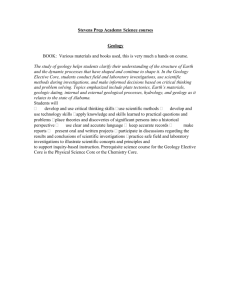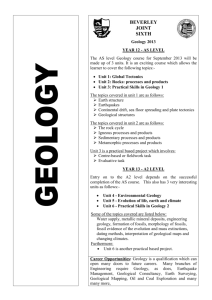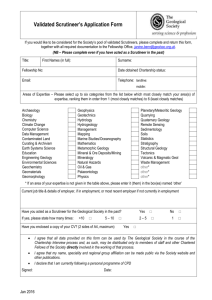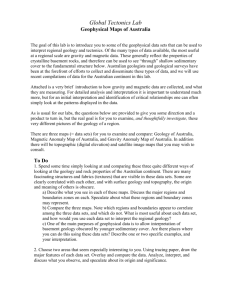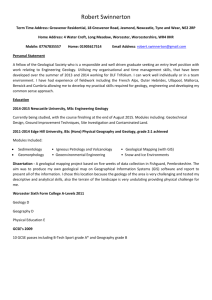ASBOG Test Blueprints
advertisement
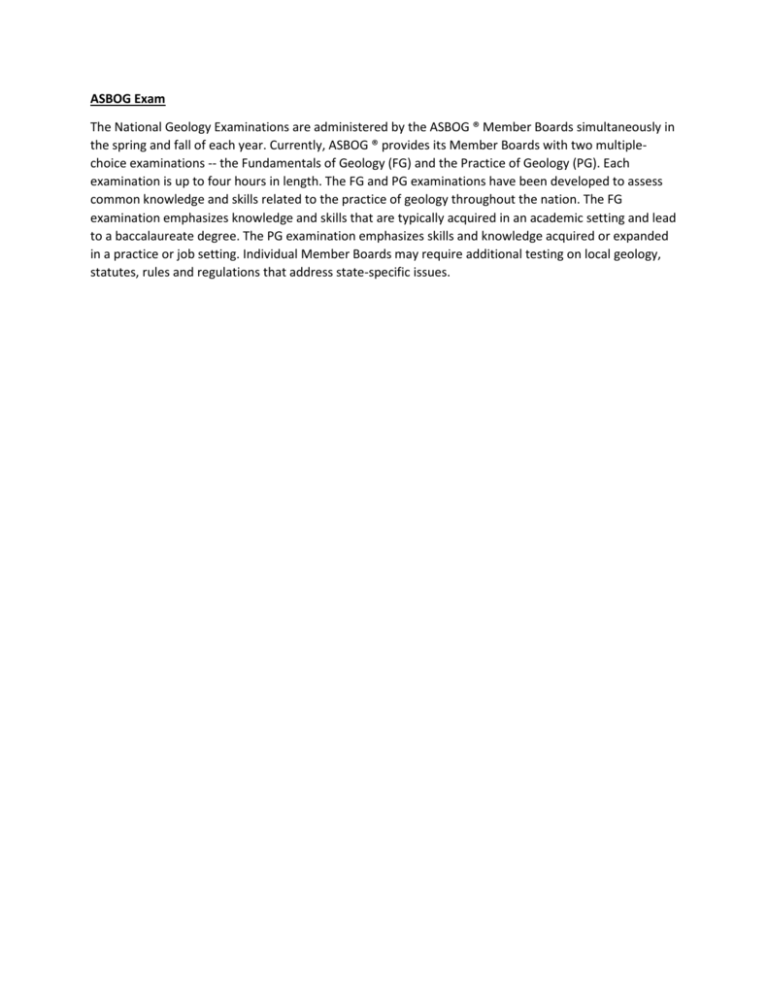
ASBOG Exam The National Geology Examinations are administered by the ASBOG ® Member Boards simultaneously in the spring and fall of each year. Currently, ASBOG ® provides its Member Boards with two multiplechoice examinations -- the Fundamentals of Geology (FG) and the Practice of Geology (PG). Each examination is up to four hours in length. The FG and PG examinations have been developed to assess common knowledge and skills related to the practice of geology throughout the nation. The FG examination emphasizes knowledge and skills that are typically acquired in an academic setting and lead to a baccalaureate degree. The PG examination emphasizes skills and knowledge acquired or expanded in a practice or job setting. Individual Member Boards may require additional testing on local geology, statutes, rules and regulations that address state-specific issues. Table 1 - ASBOG® Task Analysis 2010 FG Test Blueprint FG Test Blueprint No. Task Statements 1 2 3 4 5 7 8 9 10 12 13 14 15 17 18 19 20 22 23 24 25 27 29 30 33 35 36 39 40 41 42 A. General and Field Geology - 20% Plan and conduct geological investigations considering human health, safety, the environment, regulations, and Quality Assurance/Quality Control (QA/QC). Collect, compile, and interpret historic information to plan geological investigations. Interpret and analyze available geological and geophysical data, maps, sections, and reports. Determine scales, distances, and elevations from imagery, surveys, maps, and GIS. Prepare, analyze, and interpret logs, cross-sections, maps, and other graphics derived from field investigations and GIS applications. B. Mineralogy, Petrology, and Geochemistry - 11% Identify minerals and rocks and their characteristics. Identify and interpret rock and mineral sequences, associations, and genesis. Evaluate geochemical and isotopic data, and construct geochemical models related to rocks and minerals. Determine type, degree, and effects of rock and mineral alteration. C. Sedimentology, Stratigraphy, and Paleontology - 12% Select and apply appropriate stratigraphic nomenclature and establish correlations. Identify and interpret sedimentary processes and structures, depositional environments, and sediment provenance. Identify and interpret sediment or rock sequences, positions, and ages. Identify and interpret fossils and fossil assemblages for age or paleoenvironmental interpretations. D. Geomorhpology, Surficial Processes, and Quaternary Geology - 13% Identify, classify, and interpret landforms, surficial materials, and processes. Determine absolute or relative age relationships of landforms, sediments, and soils. Evaluate geomorphic processes and development of landforms, sediments, and soils, including watershed functions. Interpret geomorphic conditions and processes based on remote sensing and GIS. E. Structure, Tectonics, and Siesmology - 11% Identify and define structural features and relations, including constructing and interpreting structural projections and statistical analyses. Interpret deformational history through structural and tectonic analyses. Develop and apply tectonic models to identify geologic processes and history. Evaluate earthquake mechanisms, paleoseismic history, and hazards. F. Hydrogeology - 11% Define and characterize hydraulic properties of saturated and vadose zone flow systems. Evaluate water resources, assess aquifer yield, and determine sustainability. Characterize water quality and assess chemical fate and transport. G. Engineering Geology - 11% Identify and evaluate engineering and physical properties of earth materials. Identify, map, and evaluate geologic, geomorphic, and seismic hazards. Interpret land use and landforms using imagery, maps, records, GIS, and geological site characteristics. H. Economic Geology and Energy Resources - 11% Compile, assess, and evaluate the data necessary to explore for mineral and energy resources. Estimate the distribution of resources based on surface and subsurface data including imagery and GIS applications. Interpret data for economic evaluations, resource assessments, and probability of success. Determine quantity and quality of resources and reserves from laboratory, surface, and subsurface data. Total Number of Items 6 5 6 5 6 5 4 3 4 4 5 5 3 5 4 5 4 4 4 3 4 5 5 5 5 5 5 4 4 4 4 140 4 Figure 1 - ASBOG® Task Analysis 2010 FG Test Blueprint - Domain Percentages G. Engineering Geology, 11% H. Economic Geology and Energy Resources, 11% A. General and Field Geology, 20% B. Mineralogy, Petrology, and Geochemistry, 11% F. Hydrogeology, 11% E. Structure, Tectonics, and Siesmology, 11% D. Geomorhpology, Surficial Processes, and Quaternary Geology, 13% 5 C. Sedimentology, Stratigraphy, and Paleontology, 12% Table 2 - ASBOG® Task Analysis 2010 PG Test Blueprint PG Test Blueprint No. Task Statements 1 2 3 4 5 6 9 11 13 16 19 20 21 23 24 25 26 28 29 30 31 32 34 35 36 37 38 39 40 41 42 43 A. General and Field Geology - 21% Plan and conduct geological investigations considering human health, safety, the environment, regulations, and Quality Assurance/Quality Control (QA/QC). Collect, compile, and interpret historic information to plan geological investigations. Interpret and analyze available geological and geophysical data, maps, sections, and reports. Determine scales, distances, and elevations from imagery, surveys, maps, and GIS. Prepare, analyze, and interpret logs, cross-sections, maps, and other graphics derived from field investigations and GIS applications. B. Mineralogy, Petrology, and Geochemistry - 5% Plan and conduct mineralogic, petrologic, and geochemical investigations, including the use of modeling and geophysics. Evaluate geochemical and isotopic data, and construct geochemical models related to rocks and minerals. C. Sedimentology, Stratigraphy, and Paleontology - 5% Plan and conduct sedimentologic, stratigraphic, or paleontologic investigations, including the use of modeling and geophysics. Identify and interpret sedimentary processes and structures, depositional environments, and sediment provenance. D. Geomorhpology, Surficial Processes, and Quaternary Geology - 8% Plan and conduct geomorphic investigations, including the use of modeling and geophysics. Evaluate geomorphic processes and development of landforms, sediments, and soils, including watershed functions. Interpret geomorphic conditions and processes based on remote sensing and GIS. E. Structure, Tectonics, and Siesmology - 9% Plan and conduct structural, tectonic, or seismologic investigations, including the use of modeling and geophysics. Interpret deformational history through structural and tectonic analyses. Develop and apply tectonic models to identify geologic processes and history. Evaluate earthquake mechanisms, paleoseismic history, and hazards. F. Hydrogeology - 19% Plan and conduct hydrogeological, geochemical, and environmental investigations, including the use of modeling, geophysics, and isotopic and tracer studies. Design groundwater monitoring, observation, extraction, production, or injection wells. Evaluate water resources, assess aquifer yield, and determine sustainability. Characterize water quality and assess chemical fate and transport. Manage, develop, protect, or remediate, surface water or groundwater resources. G. Engineering Geology - 17% Plan and conduct environmental and engineering geological investigations, including the use of modeling and geophysics. Provide recommendations for engineering design, land use decisions, and watershed management. Identify, map, and evaluate geologic, geomorphic, and seismic hazards. Interpret land use and landforms using imagery, maps, records, GIS, and geological site characteristics. Develop programs for hazard mitigation, and land and watershed restoration. H. Economic Geology and Energy Resources - 16% Plan and conduct mineral or energy resource exploration, evaluation, and environmental programs, including the use of modeling, geophysics, and geochemistry. Compile, assess, and evaluate the data necessary to explore for mineral and energy resources. Estimate the distribution of resources based on surface and subsurface data including imagery and GIS applications. Interpret data for economic evaluations, resource assessments, and probability of success. Determine quantity and quality of resources and reserves from laboratory, surface, and subsurface data. Perform geological evaluations for design, abandonment, closure, and reclamation and restoration of energy development or mineral extraction operations. Total Number of Items 5 4 5 4 5 3 2 3 3 3 3 3 3 2 2 3 4 4 4 4 4 4 4 4 4 3 3 3 3 3 3 3 110 6 Figure 2 - ASBOG® Task Analysis 2010 PG Test Blueprint - Domain Percentages A. General and Field Geology, 21% H. Economic Geology and Energy Resources, 16% B. Mineralogy, Petrology, and Geochemistry, 5% G. Engineering Geology, 17% C. Sedimentology, Stratigraphy, and Paleontology, 5% F. Hydrogeology, 19% E. Structure, Tectonics, and Siesmology, 9% 7 D. Geomorhpology, Surficial Processes, and Quaternary Geology, 8%
